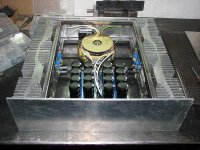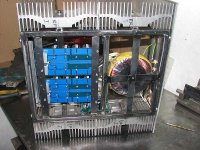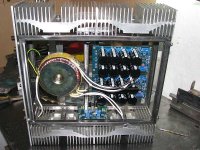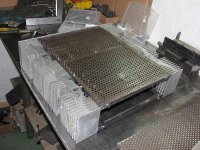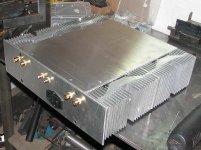Re: Antek Trannies
I didn't know he had an opinion abut this. Did he post it in the forum somewhere? I thought they were still pretty expensive at about $20 for a bridge rectifier. I was considering them, but if I don't need them I'll buy regular ones.
dcbingaman said:(BTW, Papa is not overly enamored with soft recovery rectifiers, even though they have become pretty cheap to use.....)
I didn't know he had an opinion abut this. Did he post it in the forum somewhere? I thought they were still pretty expensive at about $20 for a bridge rectifier. I was considering them, but if I don't need them I'll buy regular ones.
Re: Re: Antek Trannies
http://www.diyaudio.com/forums/showthread.php?postid=67338#post67338
labjr said:I didn't know he had an opinion abut this. Did he post it in the forum somewhere? I thought they were still pretty expensive at about $20 for a bridge rectifier. I was considering them, but if I don't need them I'll buy regular ones.
http://www.diyaudio.com/forums/showthread.php?postid=67338#post67338
Peter, I don't know how the Pass folks were measuring the "artifacts" from placing an RF transmitter on an amplifier in the post you cite -- perhaps I can lend them one of my HP spectrum analyzers.
You can hear rectifier "hash" under bad conditions -- in fact, one of the most amusing things you can and demonstrate for yourself is to take a 1N4148 or 1N400x diode and illuminate it with a fluorescent bulb -- this is why I shut off the lamps when I do THD% measurements. You can see the noise rectified in any PN junction.
You can hear rectifier "hash" under bad conditions -- in fact, one of the most amusing things you can and demonstrate for yourself is to take a 1N4148 or 1N400x diode and illuminate it with a fluorescent bulb -- this is why I shut off the lamps when I do THD% measurements. You can see the noise rectified in any PN junction.
An externally hosted image should be here but it was not working when we last tested it.
jacco vermeulen said:For soft recovery and fast you'd probably have to think about diodes like HFA16PA60.
I'm going for sound quality first. But I thought I could do better than the price of the IXYS diodes.
I used different heatsinks with those two amps, roughly I would say the demand on heat dissipation is about the same.
As to the output cap, I used Jensen 10,000/63 originally, and it sounded fine; especially with added V-Cap bypass. Getting rid of the output cap is IMHO the best mod to F3 and I made my remarks here: http://www.diyaudio.com/forums/showthread.php?postid=1722410#post1722410
As to the output cap, I used Jensen 10,000/63 originally, and it sounded fine; especially with added V-Cap bypass. Getting rid of the output cap is IMHO the best mod to F3 and I made my remarks here: http://www.diyaudio.com/forums/showthread.php?postid=1722410#post1722410
Soft Recovery Diodes
Gents, I read Papa's opinions on rectifier diodes in his power supply paper, but Peter Daniel's references above indicate that he changed his mind. In my own experience, I built a Pearl a couple years ago, (GREAT phono stage, BTW, knocked the socks off an Aragon 24K I used to have which was no slouch), and used (4) 1N4007 diodes to build the Wheatstone bridge which worked fine. I then I found an IXYS 20A soft recovery bridge, (slight overkill, I know), and replaced the 1N4007-based bridge. I noticed a distinctly QUIETER preamp with more "liquid" highs. Hard to describe, but definitely better.
I am current planning on using Fairchild ISL9R3060P2 "Stealth" diodes for my F5 bridges - 30A / 600V, and available for $ 1.96 each in lots of 10 from Digikey. These are supposed to be slightly better than the Motorola MUR 860's but my guess is you'd be hard-pressed to tell the difference - both come in TO-220 packages which fit Peter's boards nicely.
Gents, I read Papa's opinions on rectifier diodes in his power supply paper, but Peter Daniel's references above indicate that he changed his mind. In my own experience, I built a Pearl a couple years ago, (GREAT phono stage, BTW, knocked the socks off an Aragon 24K I used to have which was no slouch), and used (4) 1N4007 diodes to build the Wheatstone bridge which worked fine. I then I found an IXYS 20A soft recovery bridge, (slight overkill, I know), and replaced the 1N4007-based bridge. I noticed a distinctly QUIETER preamp with more "liquid" highs. Hard to describe, but definitely better.
I am current planning on using Fairchild ISL9R3060P2 "Stealth" diodes for my F5 bridges - 30A / 600V, and available for $ 1.96 each in lots of 10 from Digikey. These are supposed to be slightly better than the Motorola MUR 860's but my guess is you'd be hard-pressed to tell the difference - both come in TO-220 packages which fit Peter's boards nicely.
"JADBMFA JADBMFX JADBMNA JADBMNX JADBSFA JADBSFX JADBSNA JADBSNX
JADSMFA JADSMFX JADSMNA JADSMNX JADSSFA JADSSFX JADSSNA JADSSNX
JASBMFA JASBMFX JASBMNA JASBMNX JASBSFA JASBSFX JASBSNA JASBSNX
JASSMFA JASSMFX JASSMNA JASSMNX JASSSFA JASSSFX JASSSNA JASSSNX
JBDBMFA JBDBMFX JBDBMNA JBDBMNX JBDBSFA JBDBSFX JBDBSNA JBDBSNX
JBDSMFA JBDSMFX JBDSMNA JBDSMNX JBDSSFA JBDSSFX JBDSSNA JBDSSNX
JBSBMFA JBSBMFX JBSBMNA JBSBMNX JBSBSFA JBSBSFX JBSBSNA JBSBSNX
JBSSMFA JBSSMFX JBSSMNA JBSSMNX JBSSSFA JBSSSFX JBSSSNA JBSSSNX
JSDBMFA JSDBMFX JSDBMNA JSDBMNX JSDBSFA JSDBSFX JSDBSNA JSDBSNX
JSDSMFA JSDSMFX JSDSMNA JSDSMNX JSDSSFA JSDSSFX JSDSSNA JSDSSNX
JSSBMFA JSSBMFX JSSBMNA JSSBMNX JSSBSFA JSSBSFX JSSBSNA JSSBSNX
JSSSMFA JSSSMFX JSSSMNA JSSSMNX JSSSSFA JSSSSFX JSSSSNA JSSSSNX
MADBMFA MADBMFX MADBMNA MADBMNX MADBSFA MADBSFX MADBSNA MADBSNX
MADSMFA MADSMFX MADSMNA MADSMNX MADSSFA MADSSFX MADSSNA MADSSNX
MASBMFA MASBMFX MASBMNA MASBMNX MASBSFA MASBSFX MASBSNA MASBSNX
MASSMFA MASSMFX MASSMNA MASSMNX MASSSFA MASSSFX MASSSNA MASSSNX
MBDBMFA MBDBMFX MBDBMNA MBDBMNX MBDBSFA MBDBSFX MBDBSNA MBDBSNX
MBDSMFA MBDSMFX MBDSMNA MBDSMNX MBDSSFA MBDSSFX MBDSSNA MBDSSNX
MBSBMFA MBSBMFX MBSBMNA MBSBMNX MBSBSFA MBSBSFX MBSBSNA MBSBSNX
MBSSMFA MBSSMFX MBSSMNA MBSSMNX MBSSSFA MBSSSFX MBSSSNA MBSSSNX
MSDBMFA MSDBMFX MSDBMNA MSDBMNX MSDBSFA MSDBSFX MSDBSNA MSDBSNX
MSDSMFA MSDSMFX MSDSMNA MSDSMNX MSDSSFA MSDSSFX MSDSSNA MSDSSNX
MSSBMFA MSSBMFX MSSBMNA MSSBMNX MSSBSFA MSSBSFX MSSBSNA MSSBSNX
MSSSMFA MSSSMFX MSSSMNA MSSSMNX MSSSSFA MSSSSFX MSSSSNA MSSSSNX"
Anybody decipher this yet ?
Here's my (uninformed) guess:
1st letter J- JFET, M- MOSFET inputs
2nd letter A- Class A, B- Class AB, S - Sliding Bias
3rd letter D - Dual-ended power supply (+ and - rails), S - Single-ended power supply
4th letter B - ?, S - ??
5th letter - M - MOSFET output, S - ??
6h letter - F - ??, N - ??
7th letter X - Super Symmetry, N - Normal (?), A - ???
JADSMFA JADSMFX JADSMNA JADSMNX JADSSFA JADSSFX JADSSNA JADSSNX
JASBMFA JASBMFX JASBMNA JASBMNX JASBSFA JASBSFX JASBSNA JASBSNX
JASSMFA JASSMFX JASSMNA JASSMNX JASSSFA JASSSFX JASSSNA JASSSNX
JBDBMFA JBDBMFX JBDBMNA JBDBMNX JBDBSFA JBDBSFX JBDBSNA JBDBSNX
JBDSMFA JBDSMFX JBDSMNA JBDSMNX JBDSSFA JBDSSFX JBDSSNA JBDSSNX
JBSBMFA JBSBMFX JBSBMNA JBSBMNX JBSBSFA JBSBSFX JBSBSNA JBSBSNX
JBSSMFA JBSSMFX JBSSMNA JBSSMNX JBSSSFA JBSSSFX JBSSSNA JBSSSNX
JSDBMFA JSDBMFX JSDBMNA JSDBMNX JSDBSFA JSDBSFX JSDBSNA JSDBSNX
JSDSMFA JSDSMFX JSDSMNA JSDSMNX JSDSSFA JSDSSFX JSDSSNA JSDSSNX
JSSBMFA JSSBMFX JSSBMNA JSSBMNX JSSBSFA JSSBSFX JSSBSNA JSSBSNX
JSSSMFA JSSSMFX JSSSMNA JSSSMNX JSSSSFA JSSSSFX JSSSSNA JSSSSNX
MADBMFA MADBMFX MADBMNA MADBMNX MADBSFA MADBSFX MADBSNA MADBSNX
MADSMFA MADSMFX MADSMNA MADSMNX MADSSFA MADSSFX MADSSNA MADSSNX
MASBMFA MASBMFX MASBMNA MASBMNX MASBSFA MASBSFX MASBSNA MASBSNX
MASSMFA MASSMFX MASSMNA MASSMNX MASSSFA MASSSFX MASSSNA MASSSNX
MBDBMFA MBDBMFX MBDBMNA MBDBMNX MBDBSFA MBDBSFX MBDBSNA MBDBSNX
MBDSMFA MBDSMFX MBDSMNA MBDSMNX MBDSSFA MBDSSFX MBDSSNA MBDSSNX
MBSBMFA MBSBMFX MBSBMNA MBSBMNX MBSBSFA MBSBSFX MBSBSNA MBSBSNX
MBSSMFA MBSSMFX MBSSMNA MBSSMNX MBSSSFA MBSSSFX MBSSSNA MBSSSNX
MSDBMFA MSDBMFX MSDBMNA MSDBMNX MSDBSFA MSDBSFX MSDBSNA MSDBSNX
MSDSMFA MSDSMFX MSDSMNA MSDSMNX MSDSSFA MSDSSFX MSDSSNA MSDSSNX
MSSBMFA MSSBMFX MSSBMNA MSSBMNX MSSBSFA MSSBSFX MSSBSNA MSSBSNX
MSSSMFA MSSSMFX MSSSMNA MSSSMNX MSSSSFA MSSSSFX MSSSSNA MSSSSNX"
Anybody decipher this yet ?
Here's my (uninformed) guess:
1st letter J- JFET, M- MOSFET inputs
2nd letter A- Class A, B- Class AB, S - Sliding Bias
3rd letter D - Dual-ended power supply (+ and - rails), S - Single-ended power supply
4th letter B - ?, S - ??
5th letter - M - MOSFET output, S - ??
6h letter - F - ??, N - ??
7th letter X - Super Symmetry, N - Normal (?), A - ???
updating it
Last September I built one F5 clone for testing and tasting, if it meets my needs for a proper amp that would both be able to cope with my ESLs and later gave it as a loaner to my friend who would never admit that anything that iz not toobz can actually do a good job in a listening room (he has a UR845 which is about the same output power)... Anyway, I decided to do it all over again, but this time in a different housing. Had to cut the heatsinks in half to reduce the height of the box and since the plan is to have either an active system or biamping (ESL + OBLA - Open Baffle Line Array) I'm going to build two dual mono amps in two boxes.
The first time, I used what I could get, this time, I decided to go all the way and use the best I already have and pile up all the bits I think would make this amp even better. Since my knowledge about designing electronic stuff is equal to nothing but do have some basic knowledge about building amplifiers, made a new housing and am filling it up...
The amplifier and the PSU PCB is a result of some group effort on our local forum, and some of the work already has been done
Last September I built one F5 clone for testing and tasting, if it meets my needs for a proper amp that would both be able to cope with my ESLs and later gave it as a loaner to my friend who would never admit that anything that iz not toobz can actually do a good job in a listening room (he has a UR845 which is about the same output power)... Anyway, I decided to do it all over again, but this time in a different housing. Had to cut the heatsinks in half to reduce the height of the box and since the plan is to have either an active system or biamping (ESL + OBLA - Open Baffle Line Array) I'm going to build two dual mono amps in two boxes.
The first time, I used what I could get, this time, I decided to go all the way and use the best I already have and pile up all the bits I think would make this amp even better. Since my knowledge about designing electronic stuff is equal to nothing but do have some basic knowledge about building amplifiers, made a new housing and am filling it up...
The amplifier and the PSU PCB is a result of some group effort on our local forum, and some of the work already has been done
Attachments
- Home
- Amplifiers
- Pass Labs
- F5 power amplifier

